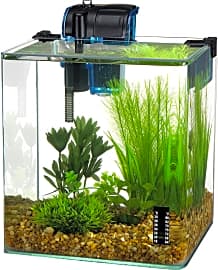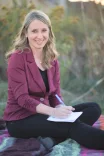The 10 Best Fish Tanks

This wiki has been updated 41 times since it was first published in March of 2015. If you ever won a goldfish from the local fair, you probably remember the basic glass bowl the little guy came in. But if you're looking to create a more comfortable and healthy aquatic ecosystem for your fish today, then one of these aquariums is sure to fit the bill. Many of our selections come as complete kits in stylish designs that include everything needed to keep piscine life thriving. When users buy our independently chosen editorial picks, we may earn commissions to help fund the Wiki.
Editor's Notes
December 31, 2019:
The MarineLand Portrait is a new addition that will be the focus of any area, thanks to its eye-catching blue and white LEDs that can create either a shimmering light or a moonlight glow effect. In addition, its filtration system is hidden behind the back panel, so all onlookers will see are your beautiful fish, plants, rocks, and other decorations. Its LEDs shine down from its hinged top fixture, and a sliding glass canopy makes it easy to access for cleaning it or feeding the fish.
For a sizable option, look to the SeaClear 50-Gallon which, like many other larger tanks, is made of acrylic rather than glass. This material gives it better durability and makes it less likely to crack or become otherwise damaged when, on occasion, someone decides to knock heavily on the outside. On the other end of the spectrum is the Penn Plax Vertex, which holds 2.7 gallons and is great for a single betta and some small, nonaggressive fish, or a group of shrimp. Its bent glass forms curved corners in the front, so you’ll enjoy an unobstructed viewing angle.
Whether you’re purchasing a kit or creating your own aquarium piece by piece, you’ll probably need to purchase a number of additional essentials and accessories. Be sure to check out our rankings of aquarium sands, underwater aquarium lights, and aquarium air pumps for some reliable, highly rated products that will make your tank both attractive and healthy for your fish and underwater plants.
Special Honors
Custom 240-Gallon Glass Aquarium Create a 30 x 72 x 24-inch environment for a large number of fish that features all the components for proper circulation, aeration, skimming capacity, and bio filtration. Its filter is a passive, gravity-fed system with low-maintenance, redundant pumps. It’s backed by a lifetime warranty when it’s ordered with a stand. It’s customizable for your fish’s needs and environment, whether you’re creating a freshwater, salt water, reef, or marine aquarium setup. The packages available range from basic through deluxe, and you can choose from a selection of backgrounds. It’s also available in an array of sizes from 65 to 500 gallons. customaquariums.com
Cobalt Aquatics C-Vue This all-in-one model makes for a great base platform when you’re setting up your fish’s environment. Its integrated filter system is discreetly concealed behind a back wall, and powerful pumps offer adjustable output nozzles to ensure good circulation of clean water throughout. Low-iron glass makes up the front and side panels, with metered corners and beveled edges for uninhibited viewing. Its bottom and back panels are crafted from non-tempered glass that’s drillable, so you can add bulkheads and plumbing, as desired. It’s available in 18-, 26-, 40-, and 45-gallon sizes. cobaltaquatics.com
Finding Nemo, Dory, And Many More
Some marine fish also have specific dietary needs, so this is important to take into account.
When it comes to taking care of small animals living in their own miniature ecosystem, a home-based aquarium can be a relaxing, inviting, and valuable addition to your home. Also known as an aquarium, a fish tank is an enclosed vivarium with at least one transparent side through which lights, plants, water, and aquatic animals are visible for display, observation, or study.
The four types of aquarium available include freshwater tropical, coldwater, marine, and brackish. Freshwater tanks are the most common and easiest to maintain, as they require no special chemical additives beyond basic water conditioners. They range in temperature from 72 to 84 degrees Fahrenheit and are ideal for accommodating many varieties of tropical fish. Coldwater aquariums maintain temperatures below 70 degrees Fahrenheit and are ideal for accommodating goldfish. Coldwater tanks are also relatively simple to maintain with the proper equipment.
Marine aquariums require a bit more maintenance than either cold and freshwater tanks, given that marine tanks need saltwater for the fish to survive. The salt is typically purchased separately before adding water into the tank itself. There are also specific types of fish that thrive in saltwater environments, so it's important to understand the distinction. Both marine fish and tanks are more expensive, as they require coral, while the fish have greater sensitivity to overall water conditions. Some marine fish also have specific dietary needs, so this is important to take into account. Brackish aquariums feature a mix of salt and fresh water, so the types of fish that can live within such an environment are limited to very few species, such as the Puffer fish. Water conditions inside a brackish tank are also difficult to keep balanced.
While fish tanks come in many different shapes and sizes, the most common construction materials include either glass or acrylic. Glass tanks are typically less expensive than acrylic, more difficult to scratch, and feature a higher refraction index, which means that light passes through the glass tank more naturally when viewing it from many different angles. However, glass tanks are also quite heavy and they can break easily if dropped. By contrast, acrylic tanks are more expensive, easy to scratch, yet lightweight and more difficult to break. However, the best view of an acrylic tank is from an angle, whereas the view can appear distorted when looking at it head on.
Other equipment that fish tanks require include heaters for ensuring the water temperature doesn't fall below required standards, thermometers to keep an eye on the consistency of that temperature, and filters to keep the water as free from waste products as possible. There are three common types of filtration systems that include biological, mechanical, and chemical. Biological filtration essentially decomposes any toxic ammonia that fish produce as a waste product. For that reason, all fish tanks are required to have biological filtration. Mechanical filtration is used to trap things like plant leaves or uneaten food, allowing it to be removed from the tank before it decomposes into ammonia. Chemical filtration can remove ammonia, heavy metals, or other dissolved organics on a limited basis, making it useful for administering and removing medicines to fish. Filters also require cleaning and maintenance.
Managing A Delicate Balance
Regardless of the type of tank chosen, you must realize that an aquarium is a living, breathing, contained, and miniaturized ecosystem with many variables to consider. These variables need to be properly balanced in order to work together and allow your fish to flourish. That said, if you're new to fish-keeping, start slowly. Invest in a small glass freshwater or coldwater tank, so you don't have to worry quite as much about treating the water.
Do be aware that glass is fragile and heavy, so you must be certain you'll have room to transport a glass tank and ample space to place it.
Just because you're new to the concept of maintaining an aquarium doesn't mean you don't have options. Many goldfish and colorful tropical fish can thrive in freshwater environments, which is great if you want to purchase a fish tank for a child to expose him or her to underwater life and how to properly care for living things. A child's exposure to fish-keeping can be a valuable precursor to owning a larger pet, such as a dog or cat.
Next, consider the size, shape, and materials of the tank you want. Do be aware that glass is fragile and heavy, so you must be certain you'll have room to transport a glass tank and ample space to place it. Some fish tanks are octagonal in shape, which can be ideal for placement in corners.
Finally, if you're unsure about the types of fish, lighting, heating, or filtration needed for the tank you choose, don't be afraid to ask questions at the pet shop you visit. The experts can help lead you in the right direction and give you all the supplies you'll need.
A Brief History Of Fish Tanks
Archaeological evidence of fish-keeping dates back to the times of the ancient Sumerians and Egyptians who considered fish to be sacred creatures as early as 2,500 BCE. The Chinese also kept goldfish and bred them selectively during the time of the Sung Dynasty between 960 and 1,279 CE. These fish were kept for purely decorative purposes, as people were forbidden to eat them.
Warington's work was published in London's Chemical Society journal in 1850.
The process of maintaining the water for a fish tank was not well understood until the time of English chemist Robert Warington, who is credited with studying the fish tank's requirement to have its water cycled in order to keep fish alive for extended periods of time. By studying a 13-gallon container full of goldfish, eelgrass, and snails, Warington succeeded in creating one of the first stable tank ecosystems. He developed the aquarium system by explaining that the addition of plants to water within a container would give off an ample supply of oxygen to support aquatic life.
Warington's work was published in London's Chemical Society journal in 1850. By 1853, the popularity of keeping aquariums as a hobby became well-entrenched in the United Kingdom, thanks in part to the ornately-designed cast-iron tanks featured at the Great Exhibition of 1851 and Philip Henry Gosse who created and stocked the first public aquarium at the London Zoo, which became known as the Fish House in 1853.
During the Victorian Era, a common design for the home aquarium was a glass front with wooden sides made watertight with a pitch coating. The bottoms of many of these tanks were constructed from slate and heated from underneath. By the nineteenth century, the tank evolved to include glass with metal framing as well as designs for hanging and wall mounting. By 1908, the first mechanical aquarium air pump was invented and powered by running water instead of electricity. As home electricity supplies became more common after World War One, tank heating, filtering, and artificial lighting became easier.
To this day, aquariums and fish-keeping are still considered to be among the most popular of hobbies with tanks being made from any combination of objects that include coffee tables, sinks, gumball machines, and even the shells of computers.















